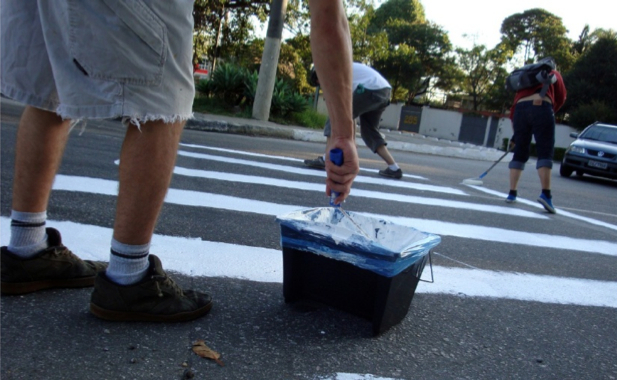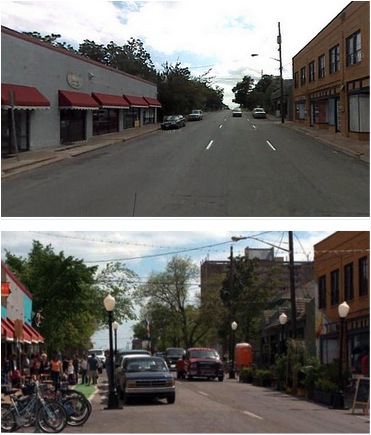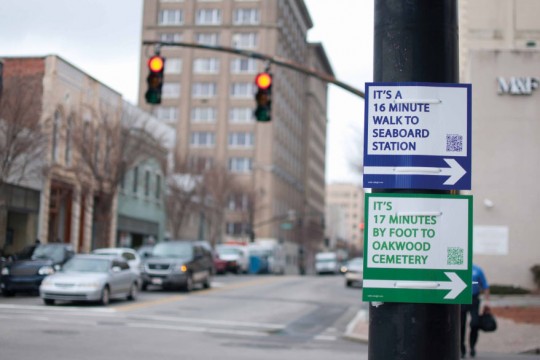You have dreamed about striping your own bike lane on your most-traveled routes. You got your street closed off for a block party. Maybe you even spent the afternoon feeding the meter on Park(ing) Day.

You just may be the next tactical urbanist to join the ranks of those who make it their business to make their cities better. These aren’t necessarily the ones who sit in community meetings and focus groups, hashing out city-drawn plans that will sit on the shelves a few years (or decades) longer. Tactical urbanists are the doers. Some transportation chiefs like Janette Sadik-Khan and Gabe Klein are doers, but you don’t need to have a top job in a major metropolitan transportation department to transform your street. You just need to be a bit of a badass.
Mike Lydon of the Street Plans Collaborative is sort of the godfather of the tactical urbanism movement. Some people can’t visualize change until they see it themselves, he told a packed forum yesterday at the National Building Museum in Washington, DC. But once they see it, they don’t want to go back.
Well, you may be thinking, it's all fine and good to get your ya-yas out for a day by doing some guerrilla gardening or what have you. People who are serious about improving their cities are just going to have to suffer through those community meetings and go through the proper channels. But Lydon says DIY urban improvement isn’t just immediate – it can be lasting, too.
In fact, most of the time, these overnight streetscape changes are made to get the attention of officials with the power to make them permanent. Even Portland’s Depave group, which literally takes a jackhammer to asphalt they don’t like, now gets funding from the city. Is there a danger of cooptation when the government starts funding and partnering with these guerrilla movements? No, Lydon says: Most of the time, getting the attention and support of people in power is the whole idea.
Lydon uses the Dallas “Build a Better Block” experiment as his starting point.

It started with a few neighborhood activists in Dallas, and they had an old mixed-use block. Unfortunately, the street had been turned to one-way, three lanes, the storefronts were all vacant, and they wanted to show the city that there could be positive change.
So what they did, very intelligently, was they circled all the ordinances they were intending to break with this intervention. They took the road down to two lanes, they added bike lanes, pop up cafés, street dining, music, all these things to enliven the street.
And when the neighborhood slowly filtered out and started to realize what that street could become, the city council person got behind it and said, “This is really amazing. Why can’t we do more of this?” And they’d already circled all the examples of why. This is why. This is forty years of institutionalized policy and ordinances that don’t even allow us to try to create this scenario on a permanent basis.
And that had a really big impact in Dallas.
In fact, the city took back jurisdiction over the street from the state highway system and made the bike lane permanent.

Planning student Matt Tomasulo had similar luck in Raleigh, North Carolina. Frustrated with the city’s foot-dragging on implementing the wayfinding in its own bike/ped plan, Tomasulo designed and posted signs himself, complete with a scannable QR code. The city first declared them illegal and told him to take the signs down – and then changed course and asked him to put them back up.
Of course, sometimes these changes do come from the top. Lydon used the example of New York’s Times Square, where visionary transportation chief Janette Sadik-Khan began to tranform a congested, pedestrian-hostile place into a car-free zone starting with nothing but lawn chairs. Since some people will always freak out when the streets change, it was important to reassure them that nothing had been done that couldn’t be undone just as fast. But people loved it. So then planters and tables came, and next, the asphalt will be replaced by concrete.
But most of the time, these actions are unsanctioned. That means anyone can take a can of paint and install a crosswalk, or grab some construction cones and close off their street to car traffic. Who will be the next person to transform a neighborhood? Will it be you?





